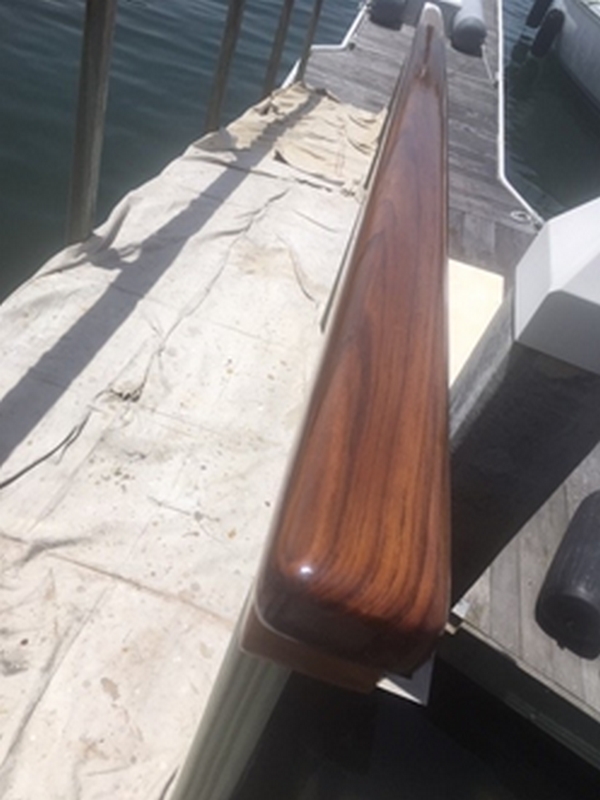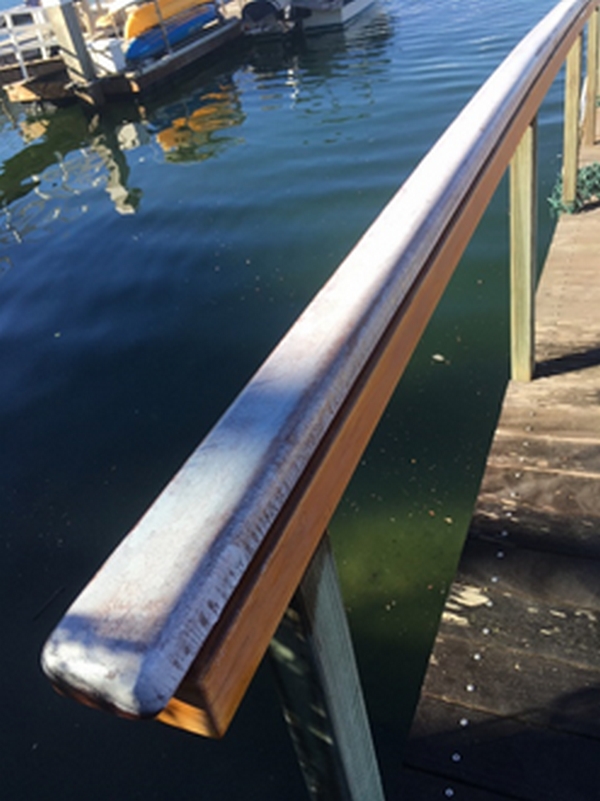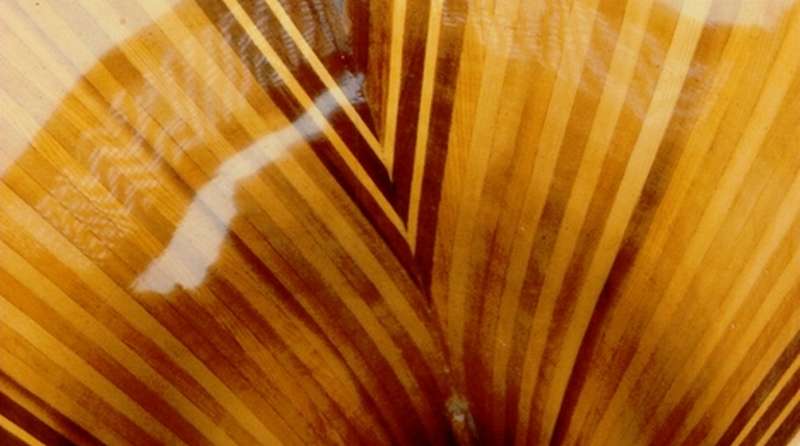
By Terry Monville — GBI Technical Advisor
Not that long ago, clear coating with epoxy meant that you were finishing a natural wood canoe or kayak, or the teak toe rails on your boat. Today, WEST SYSTEM 105 Resin and 207 Special Clear Hardener is used for clear coating in many different ways. Regardless of the project, there are some basic techniques to follow when epoxy coating and a few pitfalls to avoid.
Clear Coating Wood
Most of our customers’ projects start with some sort of wood, so that’s where I’ll begin.
Sand the wood with 80 to 120-grit sandpaper parallel to the grain using aluminum oxide sandpaper. Avoid using specially coated or non-loading sandpaper its components can be left behind, contaminating the surface.
Once you have your wood sanded, remove most of the sanding dust with a vacuum, then wipe down the wood. We recommend a two-step wiping method. Step 1: Dampen paper towels with a solvent like isopropyl alcohol, acetone or lacquer thinner. Use a solvent wipe on oily woods like teak, white oak or ipe. Step 2: Wipe off and dry the surface with clean, white paper towels.
Using a solvent on oily woods both removes the dust and helps lift the surface oils from the wood to assure better bonding. For non-oily surfaces, you can use clean water to help remove the dust.
We recommend using paper towels with solvents. If cloth towels or rags are used, solvents may loosen contaminates such as fabric softeners and detergents from the cloth fibers and deposit them on your work surface. Stay away from tack rags as the wax can easily transfer to the work surface, especially if the solvent has not completely flashed off.
Wow, that seems like a lot just to sand a piece of wood and wipe off the dust. Like most projects, 90% of the work is prep but the 10% effort spent on finish coating gets all the credit.
Clear Coating Small Items
On some smaller projects, it’s good to coat as much surface as possible. We’ve included some sketches by my old friend Captain James R. Watson, who had good ideas on how to clamp, prop or dangle a small item in order to coat it all at once.
The Importance of Freshly Mixed Epoxy
Regardless of the project, you will want to use freshly mixed epoxy. Only mix an amount you can use in about 8 to 10 minutes, and put on a seal coat of epoxy first. Depending on the size of your project, use the roll and tip method or brush the epoxy on.
Preventing Air Bubbles when Clear Coating
To seal the air into the wood without getting air bubbles in the epoxy, warm the wood slightly before applying the epoxy and let it cool as the epoxy cures. This is easy to do in a climate-controlled shop but if you’re working outdoors, use a hairdryer to warm the wood just before applying the epoxy.
After the first coat gets tacky (2 ½ to 3 hours at 72°F) apply a second coat, taking time to fill any pinholes and fix any other flaws. Again, use freshly mixed epoxy.
We’ve reached the point where it matters what kind of project you’re working on. I’ll cover two basic types of coating projects: base coat for a varnish finish, and a natural wood finish clear-coated fiberglass.
Basecoat for a varnish finish
Ideally, you would apply a total of three coats on the same day allowing 2 ½ to 3 hours between coats for the epoxy to get tacky. This can be your two seal coats plus one more if the seal coats look good and you don’t need to fix any flaws in the wood.
After the coats of 105/207 have fully cured, sand the epoxy for the varnish using the varnish manufacturer’s recommendations. The epoxy should sand to a light powder. If the epoxy is not fully cured, it will gum up the paper and could affect the finish clarity.
If you’re working outside and apply the third coat late in the day, keep an eye on the weather. 105/207 needs 8 to 10 hours above 60°F to cure before being exposed to moisture.
If the epoxy hasn’t cured enough before it’s exposed to high moisture, it may develop a milky appearance or even turn snow white. If this happens, let the epoxy finish curing, then sand until the white is removed. Apply another coat or two of epoxy and finish it with a UV protective topcoat.


Natural wood clear-coat finish with fiberglass
It’s very common in wood/epoxy construction to apply a single layer of woven fiberglass over the wood. Coating a good quality 6 oz. or less woven fiberglass with 105/207 will result in a transparent finish. Freshly mixed epoxy flows better for wetting fiberglass.
Brush on epoxy
Ted Moores, owner of Bear Mountain Boats and renowned boat builder, suggests applying the epoxy with a paintbrush for uniform fiberglass wet out and the clearest finish. Using a roller or pouring a puddle of epoxy on the fabric and spreading it around with a plastic spreader may aerate the epoxy. While the initial results will look uniform, aerated epoxy will lighten after exposure to sunlight, obscuring the beauty of the wood grain.
Apply fiberglass one layer at a time
If you need to apply more than one layer of glass (such as in the bottom of a canoe), apply the layers individually. When you apply multiple layers all at once, the lower layers act as a cushion, making it harder to squeegee out all of the air. You can exert more pressure with the squeegee over a single layer of cloth.
Squeegee with care
The object of squeegeeing is to force the epoxy into the fiberglass while forcing trapped air out. Hold the spreader at a low angle, and with enough pressure, so there is about an inch of contact against the surface.
If you don’t squeegee away excess epoxy after wetting out the cloth, it may float off of the surface at the epoxy puddle. The result will be a wavy surface and a heavier canoe. After squeegeeing, the cloth weave should project above the epoxy. If you drag the squeegee at too high of an angle, it may remove excess epoxy but won’t force the air bubbles out. If you leave air bubbles in the interstices (the small hollow at the cross weave of the fiber strands), the sun may heat it enough to create blisters. If you notice little white specs where the fabric is not completely wet, you can work epoxy into these spots by dabbing at them with a short bristle brush and gently warming the area.
Apply buildup coats on the same day
For best chemical bonding, and to avoid sanding between coats, apply the fiberglass and all of the necessary buildup coats on the same day. Apply the first build-up coat when the epoxy on the wet-out fiberglass begins to gel (about 3 hours at room temperature with 207 Hardener). Apply each remaining coat at the same interval. The epoxy buildup coats should be thick enough to provide a good moisture barrier and allow for sanding (to prepare for varnishing) without sanding into or through the fiberglass. For best results apply the buildup in thin, even coats.





